-
be quiet! TFX Power 3 Gold
Introduction
Space-saving PC cases usually lack the space for normal ATX power supplies, which means that alternative solutions are necessary. For example, one option is the TFX format. The same is significantly narrower in width and lower in height than the ATX standard. In compensation, a little more space is required in length. Due to the small size, it is difficult to accommodate complex technology for high efficiency in such power supply units. be quiet! knows about this fact and recently added interesting alternatives with the TFX Power 3 series. Despite the limited space, a modern, technical design was implemented for efficient operation. The efficiency should do justice to the 80Plus Gold logo. In the power class of 300 watts, this is currently a rarity in the TFX power supply segment. The company offer the unit in two efficiencies – 80 Plus Gold and 80 Plus Bronze. We are looking at the higher grade, more expensive 80 Plus Gold unit today. But can the space-saving power supply unit convince in our measurements and in practice despite its high efficiency? We will get to the bottom of this and many other questions in this test.
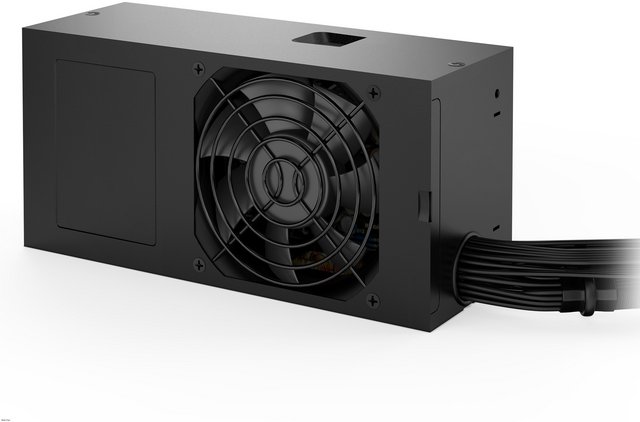
The TFX PSU form factor is much smaller than traditional ATX. A TFX power supply has to measure 85mm (W), 175 mm (D) and 65mm (H) – (compared to 150mm x 140 mm x 86 mm for standard ATX). It has been a common trend in recent years to design a power supply with a single +12V rail, however be quiet! have split this design into two that handle 13A each, for a combined 24A. It seems obvious, but this is not the kind of power supply you want to pair with a particularly demanding graphics card. According to the data sheet, be quiet has given the TFX Power 3 300W Gold all important protective circuits, including protection against undervoltage / overvoltage (UVP / OVP), overload (OPP), overcurrent (OCP) and short circuit (SCP). A protection against overheating (OTP) is also on board.
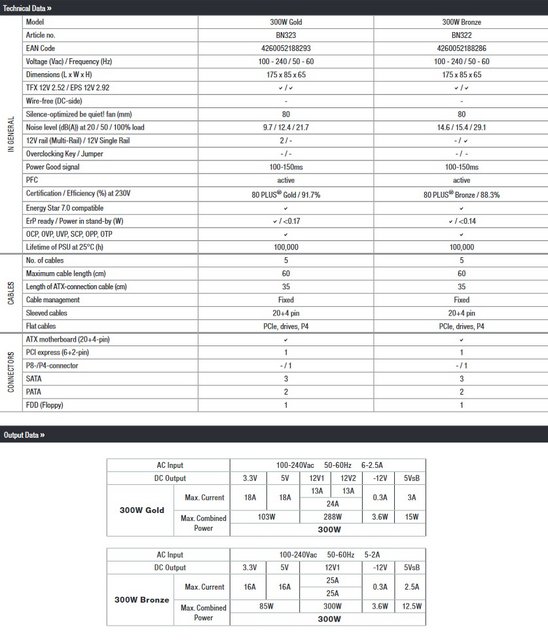
Packaging & Contents
Traditional be quiet! box artwork – simple and dark, with a high resolution image of the product on the front. The cool thing about the be quiet! packings is, that you get all the information you need on the box. Because the power supply is not particularly large, a correspondingly small packaging was chosen.

At the rear be quiet! gives information showing the power specifications tabl and the various certifications that the product has achieved. There are also a couple of stickers with one of them listing the serial number.

The power supply itself is protected with bubble wrap, which is a common type of padding in this price range.

be quiet! include a regional specific power cable, a user manual, cable ties and mounting screws.



TFX and SFX supplies are rarely modular. So no additional cables are included, and you can not remove those you do not need. The wire gauge is mostly 20 AWG, except for the ground and the +3.3 V, +5 V and +12 V lines on the motherboard power cable - there are standard 18 AWG. Normal for a low-power unit. The cable lengths are much shorter compared to ATX power supplies. Only 37 centimeters are available for the mainboard and 35 centimeters for the CPU cable. Since the distances to be overcome in housings with TFX power supplies are relatively short, we assume that the cable lengths are still sufficient. With four SATA connectors, two Molex connectors and one FDD connector, we consider the power supply unit to be sufficient.

The 6 + 2 pin additional power connector for a video card is, of course, an overkill for a compact low-power PSU. The graphics card can get 75 W of power from the PCI-E × 16 slot of the motherboard, and the 6 + 2 pin connector is another 150 W. Total: the manufacturer proposes to power a card with a consumption of 225 W from a three-hundred-watt block, excluding the processor and other consumers. It would be correct to remove two pins and leave the 6-pin connector. In this case, the consumption of the video card will be limited to 150 watts.

A Closer Look Outside
The be quiet! TFX Power 3 is a tiny, small form factor power supply. Compared to the widely used ATX form factor, TFX power supplies are much smaller. Especially with desktop systems with a thin PC case, only these PSUs often fit. The TFX Power 3 precisely adheres to the specification-compliant dimensions of 85 x 65.2 x 175 millimeters.

The unit is very nicely finished as we would expect from the German company, nothing gives under pressure and it feels sturdy in the hand. The unit passed our screwdriver test which involves running a Philips head screwdriver down the side of the chassis with weak to modest pressure. This is to try and replicate a real world situation when building a new system and accidentally connecting against the side of the chassis. On top of the supply on this picture, you can see a small notch. It is used during assembly of the system so that the relatively long power supply is held in place by other than just screws. be quiet! warn customers about removing the cover – but we went ahead and did it anyway on the next page! (and I am still alive to tell the tale…)

A small 80mm fan takes up position on one side of the chassis. It is temperature controlled. As a fan grille, one with concentric metal struts was chosen, which has been additionally reinforced and is therefore very resistant.

On the bottom is the sticker with power details and certifications. The total output of the power supply is 300 watts, of which 288 watts can be accessed on the 12 volt rail. This means that almost the entire service can be obtained from what is particularly important for modern systems. In addition, the 3.3 volt and 5 volt rails can each be loaded with 18 amps. A total of 103 watts must not be exceeded, which is generally sufficient without any problems. The 12-volt line was split over two rails, which are individually fused so that protective circuits can work particularly effectively. The CPU-P4 lines are protected via the second rail, all remaining 12-volt consumers via the other. Such a division makes sense with this power supply, although the design of the first rail with 13 amps seems a bit too tight if a graphics card is to be installed that actually consumes 150 watts. Experience has shown that the trigger values for the protective circuits are somewhat higher, so that no problems are to be expected even in this constellation.

At the end of one side is the power connector, along with vents which aid with airflow. At the opposite end unit, we have the power plug. Unfortunately, it does not have any switch, so you can not turn off the power, unless you unplug it. I think that's a bit a shame, and I might have wanted a switch to turn on and off the power supply.

The cables are firmly connected to the power supply unit. A modular solution would hardly have been helpful in this case. Overall, the sleeve is designed to be stable and opaque. To simplify production, however, the sleeve only begins after the cable has passed through. After all, the bare cables are protected with a plastic ring at the outlet.

A Closer Look Inside
The technical basis consists of an active-clamp circuit, as we know it from many other Fortron Source power supplies. In addition, there is also a secondary synchronous rectification, whereby the voltage rails are only group-regulated. The design is clean inside and due to the efficiency be quiet! have only installed a single heatsink to help with cooling directly under the small fan.

The line filtering starts directly at the input socket with one X and two Y capacitors. The cables that lead the phase and neutral conductors to the board are quite thin compared to most ATX power supplies, which is why we broke one when we took it apart. Due to the lower output power of the TFX Power 3, the choice of cable thickness is still sufficient. A ferrite core was used for further filtering at the transition.

Because these components are very close to each other, an electromagnetic shield was glued in between. A rectifier bridge was then installed, with the active PFC behind it. A Taiwanese Teapo electrolytic capacitor (420 volts, 180 microfarads, 85 degrees Celsius) is used as the primary capacitor. This is an entirely appropriate choice for a power supply of this performance class.

Because the design is based on an active-clamp circuit, a PFC / PWM controller from FSP (6600D), is installed.

The 3.3 and 5 volt rails are rectified separately, which is why the voltage rails are group-regulated and less stable voltages are to be expected than with a DC-DC step-down conversion. There are two MOSFETs on the rear for this purpose, and the associated capacitors and chokes are located on the front (to the left of the transformer).

In addition to normal electrolytic capacitors, there are also solid-state capacitors for filtering, which are expected to have a particularly long service life. With the more susceptible electrolyte energy storage systems, be quiet! mainly again on Taiwanese Teapo capacitors.


The main transformer of the TFX Power 3 was installed tilted. In the back part we could finally make out the 12-volt MOSFET for the rectification, which is attached to a small heat sink. It is interesting that only one semiconductor component is used for this. The Infineon 034NE7N with a maximum current of 100 amps seems to be sufficient for these purposes. There is also a temperature sensor on the aforementioned heat sink, which is presumably responsible for the temperature-controlled control of the fan.

A WT7527, which provides the promised protection circuits, is used as the fuse IC.

Overall, we are satisfied with the qualitative implementation. Although the soldering quality could have been better, problems are not to be expected.

The 80mm fan is made by Protechnic Electric with part number MGA8012LR-A20. This fan is rated 12V 0.15A. Little information can be found online although some investigation would indicate that fan speed peaks at 3,000 rpm. We do hope it doesn’t spin close to this speed, as it will likely be rather loud, given the small physical dimensions. This fan measures 80mm x 80mm x 20mm and is classed as a server ‘square fan’. It is a sleeve bearing fan.

Instrumentation used
Below we report the instrumentation used in the test phase for the be quiet! TFX Power 3 Gold.

PowerKiller 2.0. Test bench designed for power supplies up to 2185W.
Stingray DS1M12 USB Oscilloscope
PCE-PA 6000 Wattmeter
Range 1W ~ 6kW
Accuracy ± 1.5%
Multimeters
3 x HT81
1 x ABB Metrawatt M2004
1 x Eldes ELD9102
1 x Kyoritsu Kew Model 2001
1 x EDI T053
Scythe Kama Wireless Thermometer
Center 325 sound level meter
Voltage Regulation
The voltage regulation tests are carried out by connecting all the electrical lines to our PowerKiller and simulating the behavior of the power supply with loads comparable to those of a real location.
+ 3.3V line
Average voltage 3,363 volts
Deviation from the ideal value (3.33 volts) = + 0.99 %

+ 5V line
Average voltage 4,983 volts
Deviation from the ideal value (5.0 volts) = -0.34%

+ 12V line
Average voltage 12,135 volts
Deviation from the ideal value (12.0 volts) = + 1.12%

The linear load test shows respectable average voltages including the 5V one, which starts at no-load from a value very close to the reference value. The variations are largely due to the ohmic drops due to the reduced wiring which, being able to count on few conductors, must support full load currents of about 30A.
Efficiency
The 80Plus Gold certification that accompanies the be quiet! TFX Power 3 Gold is well deserved and with a good margin to top it off. With an average efficiency in real use conditions of 91%, we will waste about 9W per 100 absorbed by the electricity grid.
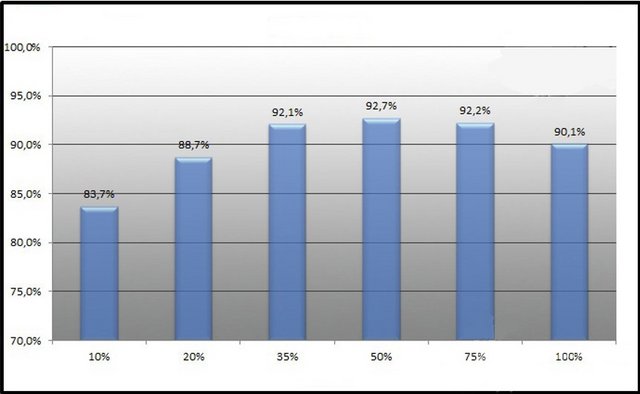
Ripple
Ripple suppression was excellent for such a compact unit. Less than 40 mV on the 12 volt and around 15mV on the other main rails is an excellent result. We see results similar to this on higher end ATX units.

3.3 volt @ 100%

5 volt @ 100%

12 volt @ 100%

Cross Load
+ 3.3V line
Maximum Vdrop 0.08 volts (2.34%)



+ 5V line
Maximum Vdrop 0.07 volts (1.39%)



+ 12V line
Maximum Vdrop 0.30 volts (2.45%)



This test, which aims to verify the robustness of the individual lines, shows respectable results with a variation of less than 2.5% on all three lines of interest. The value slightly above the limit of excellence, set at 2%, on the be quiet! TFX Power 3 Gold is mainly due to the reduced number of cables / connections that increase the voltage drop on the conductors. Considering the type of power supply and the market for which it is intended, we can still be very satisfied with the test.
APFC & OverLoad
The power factor control system (APFC) shows a good progression as the applied load increases, reaching a value of 0.98 already at 50%. Despite the limitations to the components imposed by the form factor, the power supply performs very well on a par with models of a very different range. Thanks to the combined action of the inductor and the input capacitor it is possible to minimize the phase shift between the voltage wave and the current wave, reducing the apparent power which is of no use, but negatively affects the energy electricity detected by the meter.
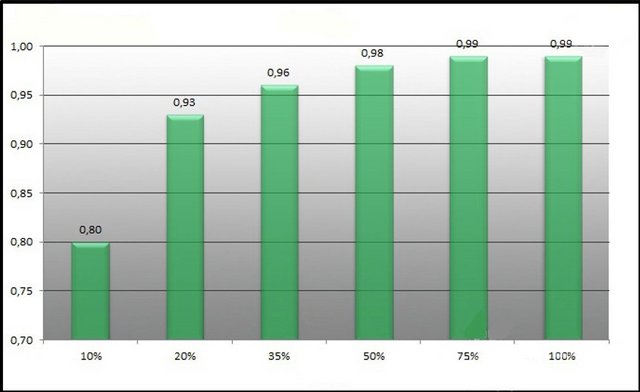
In order to verify that the electronics are adequate to manage what is declared by the manufacturer, we pass, as usual, to the overload test by which we will be able to check, in addition to the solidity of the project, also the effectiveness of the protection systems present.
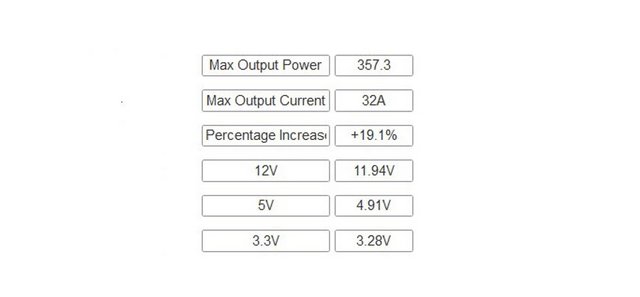
The protection system of the be quiet! TFX Power 3 Gold intervenes promptly once the supply of 357W is exceeded, this means that we will be able to push the power supply up to almost 20% more than what is indicated by the plate data. The result is undoubtedly exceptional, especially if we consider that the voltages all remain well above the minimum limit set by the ATX standard. This shows that the project and the components used have been deliberately oversized in order to deliver the indicated values in absolute tranquility. At the peak, the input power reached an efficiency close to 89.7%. As always, we suggest choosing the power supply based on the real needs of your workstation without relying on its overload capacity, which is tested by us only in order to ascertain the goodness of the internal circuitry and protection systems.
Temperature
TFX supplies don't have as much cooling capability as ATX supplies, which are usually outfitted with a 12cm fan. Our sample unit does become quite warm to the touch when under full load , but it remained working fine when left for an overnight stress test at 100 per cent capacity.
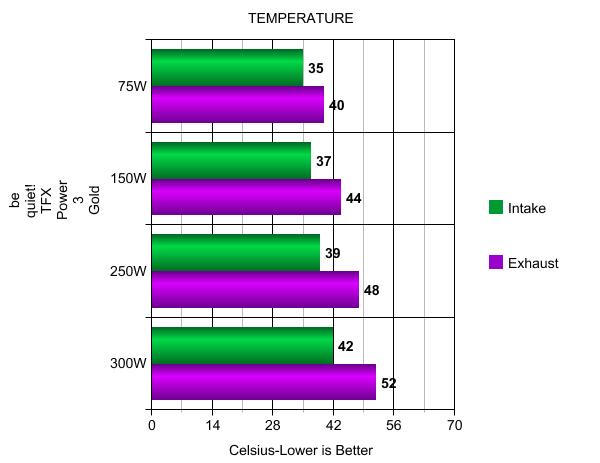
Noise
Temps are good but they mean little in isolation. At 1300 RPM the 80mm fan is near inaudible, after about 2000RPM it does become noisy and nearing 3000 RPM it was noisy. Overall the be quiet! TFX Power 3 Gold is quiet for 0-60% operation and after that the noise kicks up. To be fair this is a limitation of the form factor, it is difficult to cool 300 watts of DC power conversion and regulation in such a small space.

Final Thoughts
To properly analyze the be quiet! TFX Power 3 Gold, one must not ignore the extremely small size imposed by the form factor. In fact, there are many other power supplies on the market with higher powers and even higher performances, but none would be able to find a place inside a TFX case. Therefore, avoiding unnecessary comparisons, we can say without any doubt that be quiet! has done an excellent job on this power supply, managing to obtain respectable electrical performance with stable and clean voltages. Build quality, as we would expect, is stellar. The housing of the power supply unit is designed to be functional. We cannot discover sharp edges or unclean transitions. The length of the cables fits in most casings and purposes. Technically, the unit delivers solid load regulation and it coped with our intensive cross load testing without a hiccup. Efficiency levels are high. Especially with media systems or servers, where the hardware is always busy, the higher efficiency can definitely pay off. It was able to handle just over 357 watts before shutting down safely. It is actually a little impressive how much power can be packed down in such a little space. Ripple suppression falls within industry tolerances. The only downside is really the fact that the small fan can get a little intrusive under extended load, although this is going to be a problem with most TFX power supplies, as they have to adopt small fans to fit inside the tiny cases. Because it's temperature controlled, it will probably never come that high. It was also a little disappointing to see inside that the design is using lower grade Chinese TEAPO capacitors, including a 85c rated TEAPO capacitor in the primary stage.
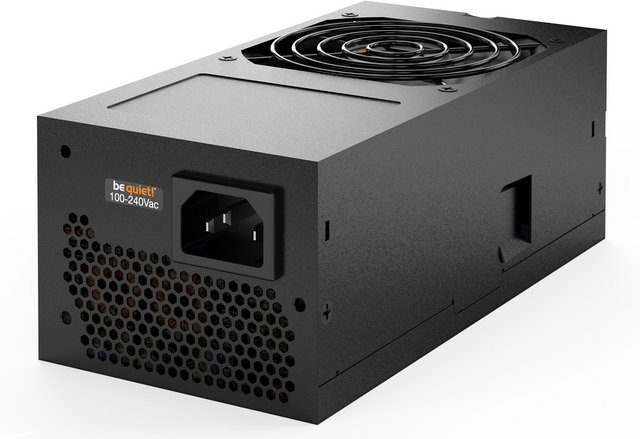
Right now there are very few instances when an enthusiast user will actually require a TFX power supply and until more case manufacturers expand their portfolio this power supply will service a limited audience. It is worth pointing out that there are two versions of this unit, a 80 Plus Bronze certified unit, and a 80 Plus Gold certified unit. Bronze is 50 Euros inc vat, and the Gold unit, which we reviewed today is slightly more expensive, at 57 Euros inc vat. German company be quiet! have earned a solid reputation for delivering quality products at various price points and this power supply will certainly help cement their track record. Why choose it? Simply because it is the best that can be found in this specific segment. Does it have any weaknesses? The comparison with the ATX counterparts is obviously uneven, but no, there are no weak points, but only slight margins for improvement. For the reasons set out above, therefore, we have decided to give the be quiet! TFX Power 3 Gold our Special Achievement Award.

Last edited by testman78; 08-04-2021 at 01:39 PM.
 Posting Permissions
Posting Permissions
- You may not post new threads
- You may not post replies
- You may not post attachments
- You may not edit your posts
-
Forum Rules























































 Reply With Quote
Reply With Quote

Bookmarks